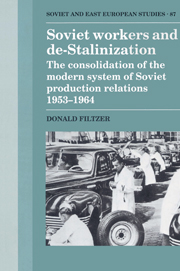 Soviet Workers and De-Stalinization
Soviet Workers and De-Stalinization Book contents
- Frontmatter
- Contents
- List of tables
- Preface and acknowledgements
- List of terms and abbreviations
- Introduction: the contradictions of-Stalinization
- Part I Labour policy under Khrushchev: issues and results
- Part II De-Stalinization and the Soviet labour process
- 5 The historical genesis of the Soviet labour process
- 6 Limits on the extraction of the surplus
- 7 The position of women workers
- 8 Skill, de-skilling, and control over the labour process
- Conclusion
- Notes
- Bibliography
- Index of industrial, mining, and construction enterprises
- General index
- Soviet and East European Studies
6 - Limits on the extraction of the surplus
Published online by Cambridge University Press: 29 January 2010
- Frontmatter
- Contents
- List of tables
- Preface and acknowledgements
- List of terms and abbreviations
- Introduction: the contradictions of-Stalinization
- Part I Labour policy under Khrushchev: issues and results
- Part II De-Stalinization and the Soviet labour process
- 5 The historical genesis of the Soviet labour process
- 6 Limits on the extraction of the surplus
- 7 The position of women workers
- 8 Skill, de-skilling, and control over the labour process
- Conclusion
- Notes
- Bibliography
- Index of industrial, mining, and construction enterprises
- General index
- Soviet and East European Studies
Summary
The primary problem which the Soviet elite faces in its attempts to administer the economy is its limited control over the production, appropriation, and disposition of both the absolute and relative surplus product. This manifests itself in a number of ways. First, the actual size and location of the surplus in pure physical form is to a large extent simply unknown. Enterprises falsify output figures or understate capacities. Part of output is literally lost in transit or warehousing. It is quite impossible to dispose of a product whose physical dimensions and whereabouts cannot be determined. Secondly, control is also undermined by the circumvention of planning directives and instructions by enterprise managers and their workers. Orders to produce a specified quantity of a particular good are frequently distorted, or even supplanted at enterprise level. The good in question is produced in the wrong amount or to the wrong specifications, or the enterprise manufactures something else altogether – either because this allows it more easily to fulfil its plan or because external circumstances (for example, the absence of the right kinds of supplies) leave it no other choice. Here, too, the centre simply has no idea of the fate of investment decisions or product orders, thus undermining attempts at coordination. Thirdly, disposition over the surplus product is constrained by the fact that the size of the actual surplus lies far below what the economy could potentially produce (or what the planners expect it to produce, which is not the same thing), essentially because of lost output.
Information
- Type
- Chapter
- Information
- Soviet Workers and De-StalinizationThe Consolidation of the Modern System of Soviet Production Relations 1953–1964, pp. 133 - 176Publisher: Cambridge University PressPrint publication year: 1992